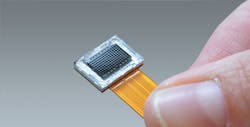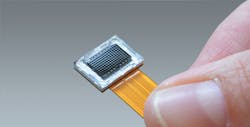Future Optics: Solid-state and fiber laser advances lead to real-world applications
OSA: How did you get involved with optics and lasers?
Andreas Tünnermann: I studied physics with Herbert Welling, a very inspiring professor who was a pioneer of photonics in Germany. When he worked in the United States, he had supplied ruby crystals to Theodore Maiman for his laser experiments. Last December, he presented a ruby crystal Maiman gave him to the German Museum in Munich.
For my post-PhD habilitation, I developed an ultrastable diode-pumped neodymium ring laser for inteferometric detection of gravity waves. Bob Byer at Stanford had introduced the technology, and we had access to the most brilliant pump diodes then available, so we teamed to make this very low-noise light source.
OSA: Was that the same type of laser used by Advanced LIGO to detect gravity waves?
AT: It was. Nobody had expected them to see gravity waves so quickly. The signal really looked perfect—I had only seen signals like that in numerical simulations. It was great.
OSA: What has made solid-state and fiber lasers so successful?
AT: The advantages of near-infrared solid-state lasers for non-contact materials processing were clear when I started in the early 1990s. But lamp pumping was inefficient and beam quality was poor because of the thermal load on the material.
Diode pumping reduced thermal loading of the solid-state material, but the thermo-optic effect still limited beam quality. So we started working on different geometries for the laser medium, including slabs and fibers. The fiber laser's waveguide properties are unique. The inner active core is doped with a rare earth-like ytterbium, and defines the beam quality. It is surrounded by a second waveguide, which confines the pump light and couples it into the active core.
The laser material is crucial, especially for fibers where the power density is very high and must withstand photodegradation. The Stokes shift between the pump line and the laser line in ytterbium is very small, so optical-to-optical conversion efficiencies can reach the 90% range. Thermal heating is so small that fiber lasers are almost immune to thermal-optic effects.
Brilliant pump sources also are important. Pumping fibers with high-power diodes resulted in very good efficiency together with very good beam quality, so fiber-laser development became my main focus in lasers for the past 20 years. The physics is on your side in the fiber geometry, but you also need very good engineering.
Fibers competed for high power with thin-disk lasers developed about the same time at the German Aerospace Center and the University of Stuttgart. In Germany, we love to play soccer, but we say you should play in the champion's league. In science, you need competition.
OSA: What interested you in micro- and nano-optics?
AT: Nanostructures let you optimize material properties for specific applications. Fused-silica nanostructures called photonic-crystal fibers have been very successful in fiber lasers. Their geometry and fill factor control the refractive index, avoiding the doping used in conventional fibers. That has a clear advantage in not adding absorbers that can limit scaling of ordinary fiber lasers.
Nanostructured fibers are especially important in developing femtosecond lasers with high peak powers. Their better control over waveguide properties allows cores to be made larger, reducing nonlinear and thermo-optic effects that limit power scaling in conventional fiber lasers. Our most advanced designs have mode-field diameter an order of magnitude larger than step-index fibers. They can be used to realize ultrafast pulses with very high average powers and excellent beam quality.
That combination is important for fundamental science and for real-world applications in high-precision micromachining. I was just at a meeting in Berkeley where we discussed laser acceleration of particles to several tera-electronvolts for basic research. Only fiber lasers could reach the high peak power and high average power that it requires. Ultrashort pulses can shape very precise microstructures and fabricate novel components for industry, but cycle time is important for manufacturing, so they need very high average power.
Ultrafast fiber lasers with high average power also are driving attosecond science by generating high-order harmonics in the extreme ultraviolet. A laboratory-sized setup based on an ultrashort fiber laser can generate a photon flux that can only be compared with the biggest free-electron lasers. That opens a way to produce attosecond pulses for time-resolved measurements or imaging.
OSA: What are you working on now?
AT: To continue scaling of ultrafast fiber lasers, we recently developed a novel technique called coherent combining. The idea is to split pulses among several parallel amplifiers, then combine the amplified pulses to form a single output pulse. We hear from the community that this is a very interesting near-term prospect. Another important goal is developing 2 μm systems based on thulium-doped fibers. Optical materials have less nonlinearity at 2 μm than at the 1 μm ytterbium line, so this might lead to further scaling of ultrafast fiber lasers.
Micro- and nano-optics also are very important for us. We have been working on making multi-aperture camera systems modeled on insect eyes. Nature optimized insect eyes for low weight, low volume, and low data processing capacity, which fits quite well with digital photography. We have made prototypes that are two to three times smaller than single-aperture lenses with the same resolution. That is a clear advantage for cell phone cameras, which are limited to the thickness of your phone.
Small size isn't all. A multi-aperture camera (see figure) also can map depth of field and pick up 3D information, unlike a single-aperture camera. That means multi-aperture cameras can be used for gesture recognition.
OSA: What trends in optics do you expect to see in coming decades?
AT: We are facing several great challenges worldwide, and light will play a very important role in solving them. Energy is one major challenge, but there are others in life sciences and medicine. Light will help us realize very high efficiencies in data transfer systems with very high throughput, and in tooling and machining systems with very high process efficiency.
We can do this by combining knowledge from different disciplines and becoming transdisciplinary. The insect-eye camera is an example where new ideas from nature are helping us realize new types of imaging. Life has evolved more than 20 different eye principles, but today's technical optics are based only on the principle of the human eye.
One other important thing now is to convince young people to study laser science and engineering. We need young scientists and engineers to address the challenges of today and tomorrow. We as academics need to make lectures attractive for students. We also need to go to school or even kindergarten to show the kids the importance of technology and the interesting things that can be done in science.
ANDREAS TÜNNERMANN is director of the Fraunhofer Institute of Applied Optics and Precision Engineering at Friedrich Schiller University in Jena, Germany. He was named a fellow of The Optical Society for his work and leadership in high-power solid-state and fiber laser technology, and his contributions to laser micromachining.
The Optical Society celebrates a century of innovation
Throughout a century of breakthroughs, The Optical Society has brought together the best minds in optics and photonics to light the future. This series reflects on that history and looks to what innovations lie ahead. For more information, please visit http://osa.org/100.

